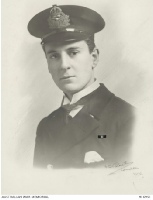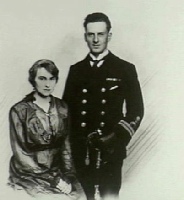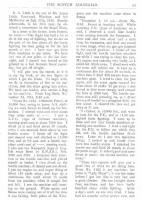He quickly earned the ire of his superiors: ‘As an officer is not very good, a nd has a bad manner’ was one comment on his service file. He also earned a reputation for luck, racking up a startling number of forced landings, some due to poor flying or inattention, most the fault of poor quality training aircraft and primitive engines. Another file annotation: ‘Has a trick of landing outside the aerodrome.’
nd has a bad manner’ was one comment on his service file. He also earned a reputation for luck, racking up a startling number of forced landings, some due to poor flying or inattention, most the fault of poor quality training aircraft and primitive engines. Another file annotation: ‘Has a trick of landing outside the aerodrome.’
Fortunately  his early service at Dover was relatively safe, for he struggled with stomach and eye problems and air sickness early on. This was probably due to fumes from castor oil that was employed as an engine lubricant, coming back on him from the engine; the problem disappeared when he transferred to other aircraft types.
his early service at Dover was relatively safe, for he struggled with stomach and eye problems and air sickness early on. This was probably due to fumes from castor oil that was employed as an engine lubricant, coming back on him from the engine; the problem disappeared when he transferred to other aircraft types.
Assigned to pilot seaplanes, which did not appeal, he was threatened with loss of his commission unless he shaped up. He did so. However, at the same time, he was having more success with his courting of Vera Gertrude Field, a young woman from Dover. He married Vera at the Congregational Church, Dover, on 16 September 1916, during a period of convalescence from pleurisy.
Little arrived in France in June 1916 for service with No. 1 (Naval) Wing at Dunkirk, where he initially flew Sopwith 1½ Strutters, undertaking reconnaissance along the coast and making bombing attacks on German installations in occupied Belgium, most notably against the submarine base at Zeebrugge, His medical troubles disappeared with the change to an aircraft which did not spray him with castor oil, and he quickly established a favourable reputation.
The Somme offensive of the second half of 1916 imposed such strain on the Royal Flying Corps that the Admiralty created new RNAS squadrons for service on the Western Front. Thus was born the famous 'Naval Eight' No 8 (Naval) Squadron, on 25 October 1916 with Flight Sub- He was assigned to "B" Flight under the command of another Australian ace, Stan Goble. Under Squadron Commander G R Bromet, they began with three flights of Nieuport 17s, Sopwith 1½ Strutters and Sopwith Pups but, by December, it was the first all-
He was assigned to "B" Flight under the command of another Australian ace, Stan Goble. Under Squadron Commander G R Bromet, they began with three flights of Nieuport 17s, Sopwith 1½ Strutters and Sopwith Pups but, by December, it was the first all-
On 23 November 1916 Little scored his first aerial victory, over a German two-



Robert Alexander Little -






